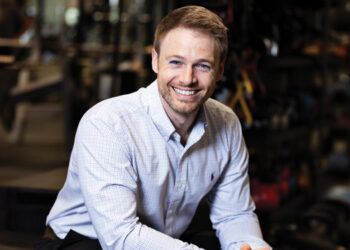For many entrepreneurs, the first few years of a new business venture are the toughest. Fear, self-doubt, financial struggles and stress often abound as you attempt to get your business off the ground, build a clientele and establish a presence in the marketplace.
Ken Davies, the founder of City Fitness in Philadelphia, can attest to this fact. Today, his six-location fitness brand is thriving. But a little over a decade ago, the operator was on the brink of bankruptcy and close to giving up on the business of his dreams.
A Rocky Start
Health and fitness had always been an important part of Davies’ life. However, it wasn’t until he played football at Millersville University of Pennsylvania that it became a true lifestyle, as Davies observed the positive impact exercise and good nutrition had on his performance on the field.
From that point on, “Fitness just became a part of my life and continued to be such even after sports,” said Davies. “It became kind of a refuge, a place for me to go and really work on myself.”
As a result, when Davies sought to move from the suburbs of Philadelphia to the inner city in order to be closer to his job in commercial real estate, one of the first things he looked for was a gym — one he could make his new fitness home.
“I spent a day walking around and noticed there wasn’t anything that really wowed me,” recalled Davies. “I had an epiphany that instead of doing real estate, I should just open up a fitness club. That night I slept on it. I woke up the next day and said, ‘Let’s give it a try.’”

So Davies drew up a business plan, found an architect, and in 2005, signed the lease on a location for his new gym, City Fitness. “I did everything the business books tell you to do,” he said.
However, when Davies went to secure a loan, he was faced with a rude awakening. “No one would lend to me,” he said. “In commercial real estate I was able to get loans easily — I thought that would be the easy part. I had a great business plan, a great location. But at the time, banks just didn’t like fitness businesses, especially start-ups.”
To top it all off, the majority of Davies’ collateral was tied up in his commercial real estate business — making it even more difficult to secure a loan.
Despite this setback, Davies had no choice but to keep moving forward. He self-financed as much of the gym’s build-out as he could afford, including $20,000 a month in rent costs, and began problem-solving ways in which to secure funding.
“I ended up trying to sell memberships to show the bank there was a real need,” said Davies. “If I could show them all these pre-sales, maybe they would take me seriously and give me a loan.”
But even after pre-selling 350 memberships, each of the banks Davies approached refused to lend to him. “So now I have members, I have a gym being built and I have no way to actually do this without lending,” he said. “I thought I was really done.”
Davies needed a Hail Mary. It came in the form of the U.S. Small Business Administration (SBA).
“I had already tried going through the SBA, but a banker I knew through my commercial real estate job asked me to let him try,” recalled Davies. “I remember sitting at my dining room table thinking, ‘This is my last chance. I’ve already wasted so much money. I’ve got people thinking I’m stealing their pre-membership fees.’ I thought I was in for another letdown.”
To say Davies was pleasantly surprised when the SBA awarded him a $1.4 million loan is an understatement. “It was a huge sigh of relief,” he said. “I thought, ‘I got this thing started — it’s now going to be a piece of cake.’”
Davies was able to finish up build-out, and the first City Fitness opened its doors in August 2007. A month later, the U.S. financial crisis began.
“The first month I had $10,000 in dues coming in, and I had about $70,000 worth of expenses each month,” said Davies. “So I was losing $60,000 a month, and obviously in an economy that’s in a financial crisis, people weren’t just knocking down my doors to sign up at a gym and pay for personal training — all the non-dues revenue wasn’t coming in.”
Davies hit a low point. He maxed out his credit cards, triple mortgaged his house, borrowed from friends and family, and even liquidated his 401K — all in an attempt to keep the lights on and pay his staff.
“I was just about to file for bankruptcy because I just couldn’t keep it up,” said Davies. “We weren’t moving the dial. But through all of this, I was learning the industry, because before I had zero idea what I was doing. There’s nothing like sleeping in your car for seven days and losing all of your money to really focus yourself on learning a new career.”
Realizing that customers spend their dollars differently in an economic downturn, Davies decided to shift City Fitness’ business plan. He lowered membership prices from $59.99 to $19.99 per month. In addition, he implemented a small group training program, so customers would have a more affordable option for personalized instruction.
“Those two changes allowed us to earn enough memberships and non-dues revenue to cover our expenses,” said Davies. “I was able to stop the bleeding and at least breathe.”
The Turning Point

With City Fitness on solid ground, Davies was finally able to focus on growth. Over the next five years he continued to refine the business model and implement all of the things he’d learned during his crash-course in gym operations.
For example, one of the biggest learning lessons for Davies was realizing the importance of having a solid management team he could not only trust, but rely on. “I needed to find management staff that had the same passion and belief systems I did,” he explained.
This led to the creation of City Fitness’ three core values — smile, clean and cutting-edge — that management staff could rally around.
“We had a mission statement, but the core values allowed us to quantify what we were doing,” said Davies. “They seem very simplistic, but are very hard to do well day in and day out. Once we began operating that way, that’s where City Fitness really started to gel and build a bigger and better brand.”
The next turning point came in 2012, when City Fitness was well positioned to open a second location. But this time around, Davies was determined to avoid the struggles that came during the first.
“From what I learned, I knew what I needed from the landlord, and because we were still coming out of a recession, I was able to ask and get a lot of tenant improvement dollars,” explained Davies. “I was able to front all of the build-out and get a year’s free rent.”
Davies also realized the importance of a strong pre-sale, and set a goal of opening with 1,200 members, versus the 350 the first location had earned.
As a result, City Fitness’ second location was profitable on Day 1.
Pillar of the Community
Since, City Fitness has used the second location’s roadmap for success to launch three additional gyms in key neighborhoods throughout Philadelphia — with a sixth in the works.
However, each City Fitness club is anything but cookie-cutter. According to Tom Wingert, the brand’s vice president of marketing, every location features a unique design, layout and color scheme — handpicked to be a reflection of the community it resides in. This not only applies to the gym’s look and feel, but also its amenities and programming.
“There is a point where a gym is just a gym,” said Wingert. “We have to look at opportunities that really differentiate us and make us a community institution. It’s a differentiated customer experience.”
The community-based approach extends to the brand’s marketing strategy, which emphasizes engagement over the promotion of amenities or programs.
“When you look at our marketing materials, we rarely, if ever, talk about fitness,” explained Wingert. “What we’re talking about is the stuff people who go to our gyms do — whether that’s going to concerts or rooting for their sports teams — that people really care about.”
In addition, City Fitness invests in experiences that engage people in its community — both members and non-members — outside of its four walls. In 2016, it launched the #MyCityMoves fitness campaign, which encouraged the residents of Philadelphia to get moving for a chance to win cash prizes.
This past August, City Fitness hosted a workout bash for 250 people at The Fillmore concert venue, in celebration of its 11th anniversary. The event featured three local DJs, group workouts and ended with a performance by Mike Taylor, a pop artist from Philadelphia. All proceeds went to the Make the World Better foundation, founded by former Eagles player Connor Barwin.
“Events like this are the type of thing people remember, and by doing stuff like that over and over, we become a brand that doesn’t just exist when people check in three times a week for an hour,” said Wingert. “We’re having a presence in people’s lives and we can really contribute to them outside of just their time on a treadmill.”
As Davies explained, this has been his dream for City Fitness from the start — to create a brand that serves as a pillar in the community for those seeking to live an active lifestyle.
“We are part of a community, and we have to engage the community as a whole and get more people living that active lifestyle,” added Davies.
Bright Future
As Davies ponders the next steps for City Fitness, he also takes time to reflect. Although years have passed since City Fitness’ rocky start, he explained the struggles that occurred during that time period are never far behind.
“I still feel it in my bones where we started,” said Davies. “No matter how good we’re doing, you just always have that in the back of your mind — how it almost was gone.”
But with reflection, are causes for celebration.
City Fitness East Market — its sixth location — is just weeks away from opening. It will serve as a flagship for the brand, taking up 36,000 square feet of prime real estate in downtown Philadelphia. Highlights include 30-foot tall glass windows, a coworking space, floating mezzanine and five group fitness rooms.
In addition, Davies and his team are discussing the possibility of expanding the City Fitness brand to other cities. “We are a Philadelphia brand and we’re still focused here, but there’s definitely a cry from other cities that are like, ‘Hey, we would love to have a City Fitness here.’ And I’ve been listening to them.”
Each current success, and those to come, solidify City Fitness as a case study in the merits of perseverance.
“Have persistence,” said Davies. “You’re going to have challenges — big ones, small ones, maybe even catastrophic ones. Because ultimately you can get through those challenges as long as you stay true to your values and keep working.”
Stay ahead in the fitness industry with exclusive updates!
Rachel Zabonick-Chonko is the editor-in-chief of Club Solutions Magazine. She can be reached at rachel@peakemedia.com.





















Comments 4